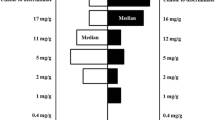Abstract
A significant problem in assessing the relative relevance of nicotine and tar yield for compensatory smoking after switching from high to low yield cigarettes is that nicotine and tar yield are highly intercorrelated across conventional cigarettes and that the tar/nicotine ratios vary only within a modest range. A better differentiation between the impacts of nicotine and tar yield was expected by comparing in a laboratory experiment a new low nicotine/medium tar cigarette (“Next”) with conventional low nicotine/low tar (ultra-light) cigarettes and with medium nicotine/medium tar cigarettes with respect to nicotine absorption and physiological effects. Twelve females, habitually smoking medium type cigarettes (≥0.7 mg nicotine) participated in the study. Neither the number of cigarettes smoked under field conditions nor the puffing behavior during the laboratory experiment differed between the three types of cigarettes. In the laboratory, Next produced only very small increases in plasma nicotine and changes in cardiovascular or EEG measures, whereas the effects of the medium cigarettes were in the expected range and those of the ultra-light cigarettes about halfway in between. The nicotine absorption/nicotine yield and the CO absorption/CO yield ratios were similar for Next and the habitual cigarettes, but about twofold higher for the ultra-light cigarettes. This suggests that gustatory and olfactory sensations, which are supposed to be more dependent on tar than on nicotine yield, may play a greater role for the regulation of smoking behavior than hitherto believed.
Similar content being viewed by others

References
Armitage AK, Alexander J, Hopkins R, Ward C (1988) Evaluation of a low to middle tar/medium nicotine cigarette to maintain nicotine delivery to the smoker. Psychopharmacology 96:447–453
Bättig K, Buzzi R, Nil R (1982) Smoke yield of cigarettes and puffing behavior in men and women. Psychopharmacology 76:139–148
Fertig JB, Pomerleau OF, Sanders B (1986) Nicotine-produced antinociception in minimally deprived smokers and ex-smokers. Addict Behav 11:239–248
Feyerabend C, Russell MAH (1990) A rapid gas-liquid chromatographic method for the determination of cotinine and nicotine in biological fluids. J Pharm Pharmacol 42:450–452
Hasenfratz M, Nil R, Bättig K (1990) Development of central and peripheral physiological smoking effects over time. Psychopharmacology 101:359–365
Herskovic JE, Rose JE, Jarvik ME (1986) Cigarette desirability and nicotine preference in smokers. Pharmacol Biochem Behav 24:171–175
Höfer I, Nil R, Bättig K (1991) Nicotine yield as determinant of smoke exposure indicators and puffing behavior. Pharmacol Biochem Behav 40:139–149
Hughes IR, Hatsukami DK, Pickens RW, Krahn D, Malin S, Liunic A (1984) Effect of nicotine on the tobacco withdrawal syndrome. Psychopharmacology 89:82–87
Hummel T, Hummel C, Pauli E, Kobal G (1992a) Olfactory discrimination of nicotine-enantiomers by smokers and nonsmokers. Chem Senses 17:13–21
Hummel T, Livermore A, Hummel C, Kobal G (1992b) Chemosensory event-related potentials in man: relation to olfactory and painful sensations elicited by nicotine. Electroencephalogr Clin Neurophysiol 84:192–195
Levin ED, Behm F, Rose JE (1990) Development of a citric acid aerosol as smoking cessation aid. Drug Alcohol Depend 25:273–279
Nemeth-Coslett R, Henningfield JE, O'Keeffe MK, Griffiths RR (1986) Effects of mecamylamine on human cigarette smoking and subjective ratings. Psychopharmacology 88:420–425
Nil R (1991) A psychopharmacological and psychophysiological evaluation of smoking motives. Rev Environ Health 9 [2]: 85–115
Nil R, Bättig K (1989) Smoking behavior: a multivariate process. In: Ney T, Gale A (eds) Smoking and human behavior. Wiley, Chichester, pp 199–221
Robinson JH, Pritchard WS, Davis RA (1992) Psychopharmacological effects of smoking a cigarette with typical “tar” and carbon monoxide yields but minimal nicotine. Psychopharmacology 108:466–472
Rose JE (1988) The role of upper airway stimulation in smoking. In: Pomerleau OF, Pomerleau CS (eds) Nicotine replacement: a critical evaluation. Liss, New York, pp 95–106
Rose JE, Hickman C (1988) Citric acid aerosol as a potential smoking cessation aid. Chest 92:1005–1008
Rose JE, Levin ED (1991) Inter-relationships between conditioned and primary reinforcement in the maintenance of cigarette smoking. Br J Addict 86:605–609
Rose JE, Levin ED, Behm FM, Adivi C, Schur C (1990) Transdermal nicotine facilities smoking cessation. Clin Pharmacol Ther 47:323–330
Rose JE, Sampson A, Levin ED, Henningfield JE (1989) Mecamylamine increases nicotine preference and attenuates nicotine discrimination. Pharmacol Biochem Behav 32:933–938
Rosenthal R, Rosnow RL (1985) Contrast analysis: focused comparisons in the analysis of variance. University Press, Cambridge.
Stepney R (1981) Would a medium nicotine, low tar cigarette be less hazardous to health? BMJ 283:1292–1296
Sutton SR, Russell MAH, Iyer R, Feyerabend C, Saloojee Y (1982) Relationship between cigarette yields, puffing patterns, and smoke intake: evidence for tar compensation? BMJ 285:600–603
Author information
Authors and Affiliations
Rights and permissions
About this article
Cite this article
Hasenfratz, M., Baldinger, B. & Bättig, K. Nicotine or tar titration in cigarette smoking behavior?. Psychopharmacology 112, 253–258 (1993). https://doi.org/10.1007/BF02244919
Received:
Revised:
Issue Date:
DOI: https://doi.org/10.1007/BF02244919



